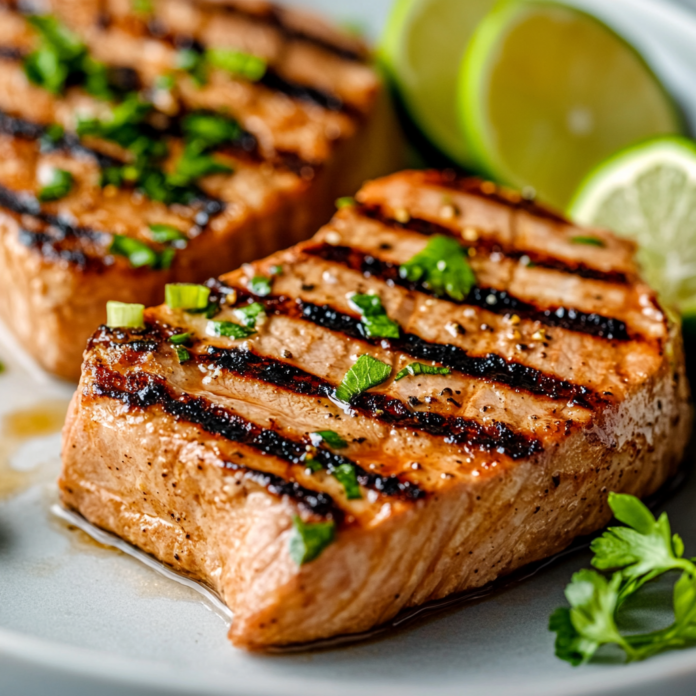Introduction and Quick Summary
Grilled Tuna Steaks offer a delightful combination of flavors and textures that make them a go-to choice for seafood lovers. The juicy, meaty texture of fresh tuna can transform a simple dinner into a gourmet experience. This dish is not only delicious but also quick to prepare. Whether you’re hosting a summer barbecue or enjoying a cozy dinner at home, grilled tuna steaks are sure to impress your guests. In this recipe, we’ll guide you through the process of preparing perfectly grilled tuna steaks that are seasoned just right.
The beauty of grilled tuna lies in its versatility. You can pair it with various marinades and side dishes to create an unforgettable meal. Our recipe includes simple yet effective ingredients that enhance the natural flavor of the fish without overpowering it. As we dive into this culinary adventure, you’ll learn about selecting the best tuna steaks, preparing them for grilling, and serving them with tasty accompaniments. By the end of this article, you’ll feel confident in your ability to grill tuna steaks like a pro.
So roll up your sleeves and get ready to enjoy a delicious serving of grilled tuna steaks that will have everyone asking for seconds!
Main Ingredients
Fresh Tuna Steaks
Fresh tuna steaks are the star of this recipe. When selecting your fish, look for bright red color and minimal browning around the edges. Freshness is key; if possible, buy from a trusted fishmonger or local market. For optimal flavor and texture, choose steaks that are at least one inch thick; this ensures they remain moist during grilling.
Olive Oil
Olive oil plays a significant role in enhancing the flavor of grilled tuna steaks. It helps in achieving that perfect sear while preventing the fish from sticking to the grill grates. Aim for high-quality extra virgin olive oil for its rich taste and health benefits. You’ll need about two tablespoons for marinating the fish.
Soy Sauce
Soy sauce adds depth and umami flavor to your marinade. It beautifully complements the natural taste of tuna while providing essential saltiness without overpowering it. Use low-sodium soy sauce if you prefer less salt in your diet; about three tablespoons will work wonders in this recipe.
Lemon Juice
Fresh lemon juice brightens up the dish and balances the richness of the fish with its tangy flavor profile. The acidity from lemon juice acts as a natural tenderizer while adding freshness to each bite. You will need juice from one medium lemon—about two tablespoons—to achieve that zing.
Garlic
Garlic is an essential ingredient that infuses your grilled tuna steaks with aromatic flavors. Mince two cloves of garlic finely; it will enhance both the marinade’s taste and aroma as it grills. Garlic provides not only flavor but also health benefits such as anti-inflammatory properties.
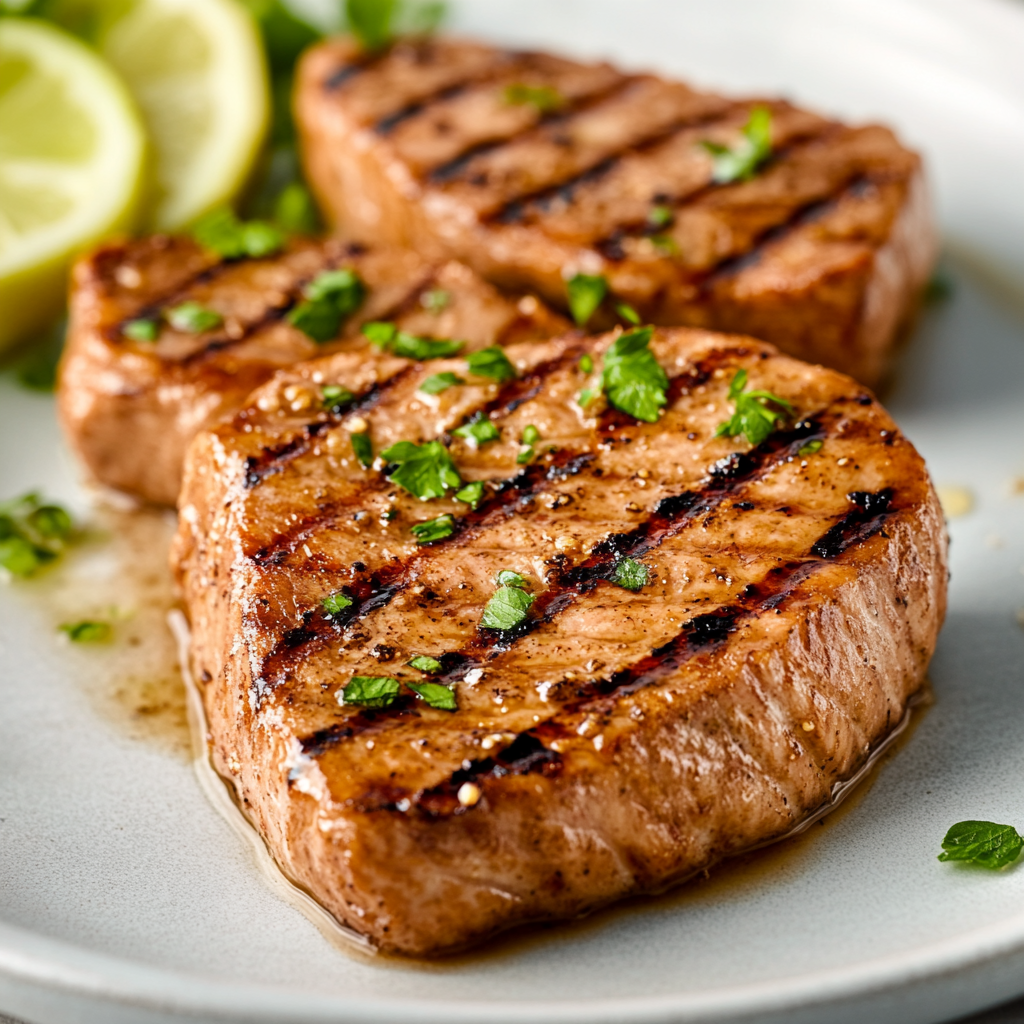
How to Prepare Grilled Tuna Steaks
Preparing the Marinade
Begin by gathering all your ingredients for the marinade in a medium bowl—combine olive oil, soy sauce, freshly squeezed lemon juice, minced garlic, salt, and pepper according to your taste preferences. Whisk together until well blended; this simple mixture will serve as both a marinade and basting sauce during grilling.
Once combined, place your fresh tuna steaks into a resealable plastic bag or shallow dish and pour half of the marinade over them until fully coated. Seal or cover tightly and allow them to marinate in the refrigerator for at least 30 minutes or up to two hours for more intense flavors—this step is crucial as it infuses moisture into each steak while tenderizing them effectively.
While marinating is underway, preheat your grill to medium-high heat (around 400°F). This ensures even cooking while allowing those beautiful grill marks to form on each piece of fish.
Grilling Your Tuna Steaks
After marination time has passed, remove your tuna steaks from refrigeration and let them sit at room temperature for about 10 minutes before grilling—this helps ensure even cooking throughout each steak without drying out any parts during grilling.
Once heated adequately, place each steak directly onto the hot grill grates; avoid overcrowding so they cook evenly without steaming themselves! Grill for about 2-3 minutes on one side until you see nice char marks forming before flipping carefully using tongs or a spatula—it’s essential not to pierce through any flesh during flipping!
After flipping onto their other sides, brush remaining marinade over each piece generously while continuing to cook for another 2-3 minutes depending on thickness desired doneness level (medium-rare typically takes around 5-6 total). A meat thermometer inserted should read approximately 130°F when done if aiming towards medium-rare perfection!
Resting Before Serving
Once cooked perfectly through yet still moist inside from all that great marinade action earlier—you’ll want those juices preserved! Remove from heat carefully then transfer onto plates lined with paper towels (to absorb excess oil). Allow resting period lasting around 5 minutes before slicing into portions; this allows flavors settle nicely throughout every bite ensuring maximum deliciousness when served!
During resting time consider preparing any sides you’d like accompanying these fantastic grilled creations—they pair well alongside roasted vegetables like asparagus or zucchini drizzled lightly with olive oil too!
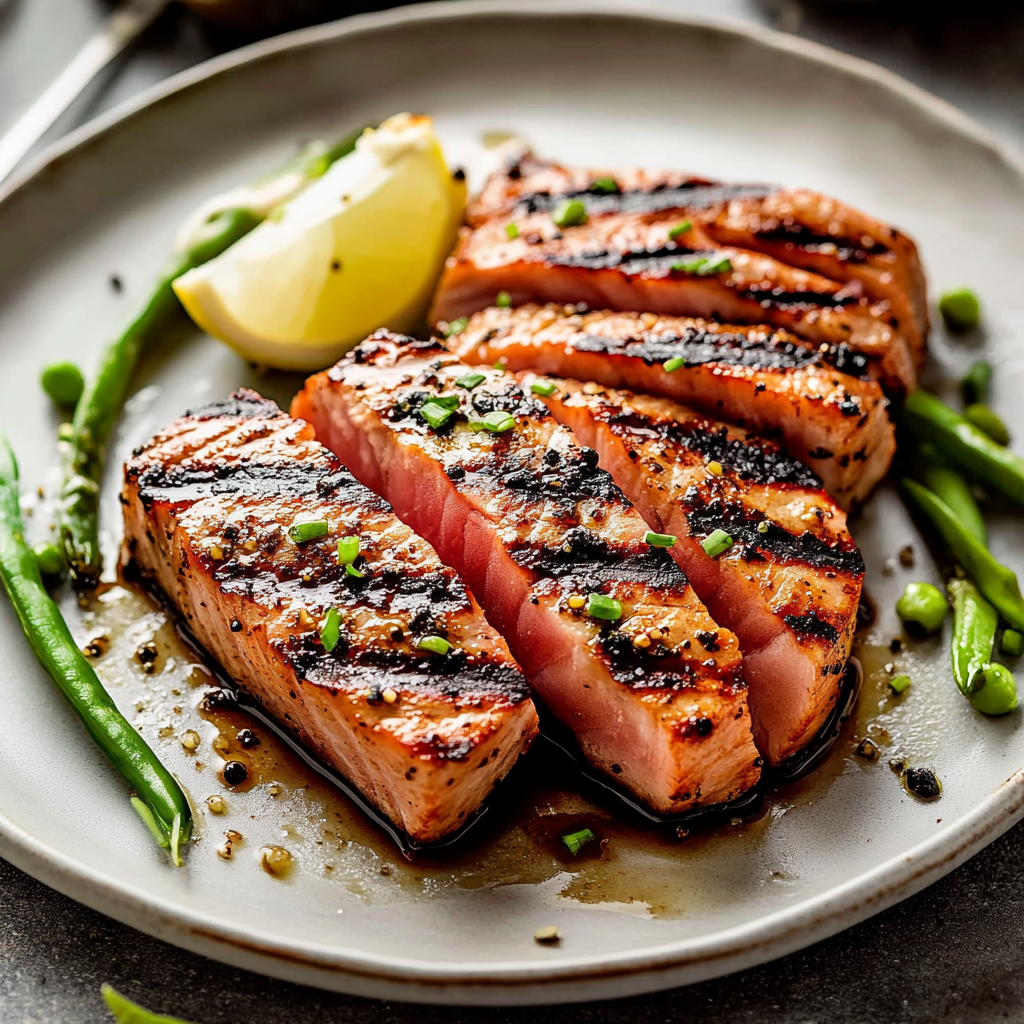
Serving and Storing Tips
Serving Suggestions
Grilled Tuna Steaks shine brightest when paired with complementary sides that enhance their flavors without overshadowing them! Consider serving alongside vibrant salads featuring mixed greens tossed lightly in vinaigrette dressing or even citrus-based slaws—these add brightness while balancing richness found within those delectable fish fillets!
For added flair present these beauties garnished fresh herbs such as parsley or cilantro along with thinly sliced lemons arranged artfully around plate edges creating visual appeal too! Another fun idea could involve topping cooked pieces off avocado slices drizzled balsamic reduction giving creamy texture contrast against firm yet tender flesh!
Consider also offering various dipping sauces alongside such as wasabi mayo or spicy aioli inviting guests customize according preferences making meal more interactive enjoyable experience altogether—not forgetting crusty bread slices ideal mopping up juices left behind afterward!
Storage Tips
If you happen find yourself with leftover grilled tuna (though unlikely!), proper storage becomes essential maintaining quality! Allow cooled pieces cool down room temperature first then wrap tightly using plastic wrap or store inside airtight containers refrigerating promptly keeping freshness intact duration maximum two days afterwards!
When reheating leftovers aim utilize lower temperature settings (around 300°F) ensuring gradual warming preserves moisture instead drying out delicate flesh completely ruining greatness achieved originally! Alternatively cold leftovers can be enjoyed flaked atop salads integrating seamlessly flavorful way keep things exciting even second time around too!
By following these simple guidelines you’re sure elevate overall experience surrounding delicious grilled creations bringing joy dining table every single time enjoyed!
Mistakes to avoid
One common mistake when grilling tuna steaks is overcooking them. Tuna is best enjoyed medium-rare, where the center remains pink and moist. If you leave the steaks on the grill for too long, they can become dry and tough. To avoid this, monitor the cooking time closely. Aim for about 4-5 minutes per side for a one-inch thick steak. Use a meat thermometer to check the internal temperature; it should reach around 125°F (51°C) for perfect doneness.
Another mistake is not seasoning the tuna properly. While tuna has a rich flavor on its own, seasoning enhances its taste significantly. A simple mixture of salt, pepper, and olive oil can elevate your dish. Consider marinating your tuna steaks for at least 30 minutes before grilling. This allows the flavors to penetrate the fish, providing a more robust taste experience.
Using a dirty grill is another error that can ruin your grilled tuna steaks. Residue from previous cooks can impart unwanted flavors or even cause sticking. Always clean your grill grates before starting to ensure even cooking and prevent your tuna from adhering to the surface. A well-oiled and clean grill will help achieve those beautiful sear marks while keeping the fish intact.
Lastly, neglecting to let the steaks rest after grilling is a mistake many home cooks make. Resting allows the juices within the fish to redistribute, resulting in a more flavorful and tender steak. Allow your grilled tuna steaks to rest for about 5 minutes before slicing into them, which helps retain moisture and enhances overall flavor.
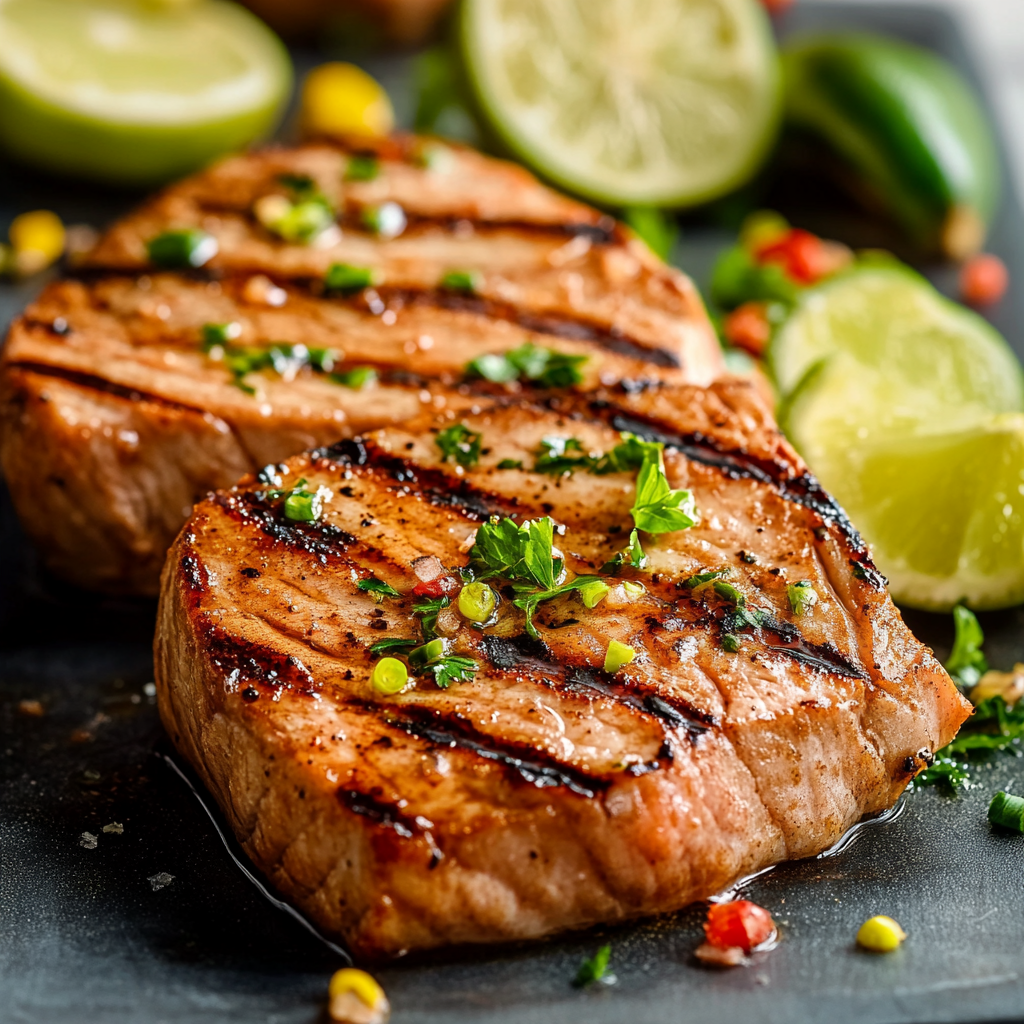
Tips and tricks
To achieve perfectly grilled tuna steaks, start with high-quality fish. Freshness matters greatly when it comes to seafood; opt for sushi-grade tuna if possible. This type of fish has been carefully handled and stored to maintain its quality. Check with local fish markets or reputable grocery stores that specialize in fresh seafood.
Preheating your grill is essential for successful grilling. A hot grill sears the outer layer of the fish quickly, locking in moisture and flavor while creating delicious grill marks. Preheat your grill to medium-high heat (around 400°F or 204°C) before placing your tuna steaks on it. This step makes all the difference in achieving that perfect crust without overcooking.
Consider using indirect heat when grilling thicker cuts of tuna steak. Instead of placing them directly over flames, move them to a cooler side of the grill after searing each side briefly. This technique helps cook through without burning or drying out the outside while keeping the center juicy.
Don’t be afraid to experiment with flavors! Tuna pairs beautifully with various marinades and rubs such as citrus-based sauces or Asian-inspired mixtures featuring soy sauce and ginger. Adding spices like smoked paprika or chili powder can also complement its natural taste well.
Finally, invest in quality grilling tools such as long tongs and a good spatula designed for flipping delicate fish fillets. Using these tools helps prevent tearing or breaking apart your grilled tuna steaks while allowing you to maneuver them easily on the grill.
Suggestions for Grilled Tuna Steaks
When preparing grilled tuna steaks, consider serving them alongside fresh salads or grilled vegetables for a complete meal experience. A vibrant salad made with arugula, cherry tomatoes, cucumbers, and a light vinaigrette pairs excellently with grilled fish, enhancing both flavor profiles without overpowering them.
You may also want to explore different sides that complement grilled tuna steaks well. For instance, roasted asparagus drizzled with lemon juice adds brightness and crunch that balances out rich flavors from the fish itself. Quinoa or couscous salads seasoned with herbs provide an excellent source of fiber while adding an interesting texture contrast.
If you’re looking for an alternative cooking method besides grilling outdoors, try using an indoor grill pan or broiler in your oven instead! These methods allow you to cook indoors without sacrificing flavor or texture—perfect during colder months when outdoor grilling seems less inviting!
For additional flavor complexity, consider topping your grilled tuna steaks with salsas or relishes made from tropical fruits like mango or pineapple mixed with lime juice and cilantro; this combination enhances freshness while balancing savory elements beautifully.
Lastly, think about garnishing options! Fresh herbs like cilantro or parsley not only add color but also enhance visual appeal—and their subtle aromas uplift every bite! Keeping these suggestions in mind will elevate any grilled tuna steak recipe into something truly delightful!
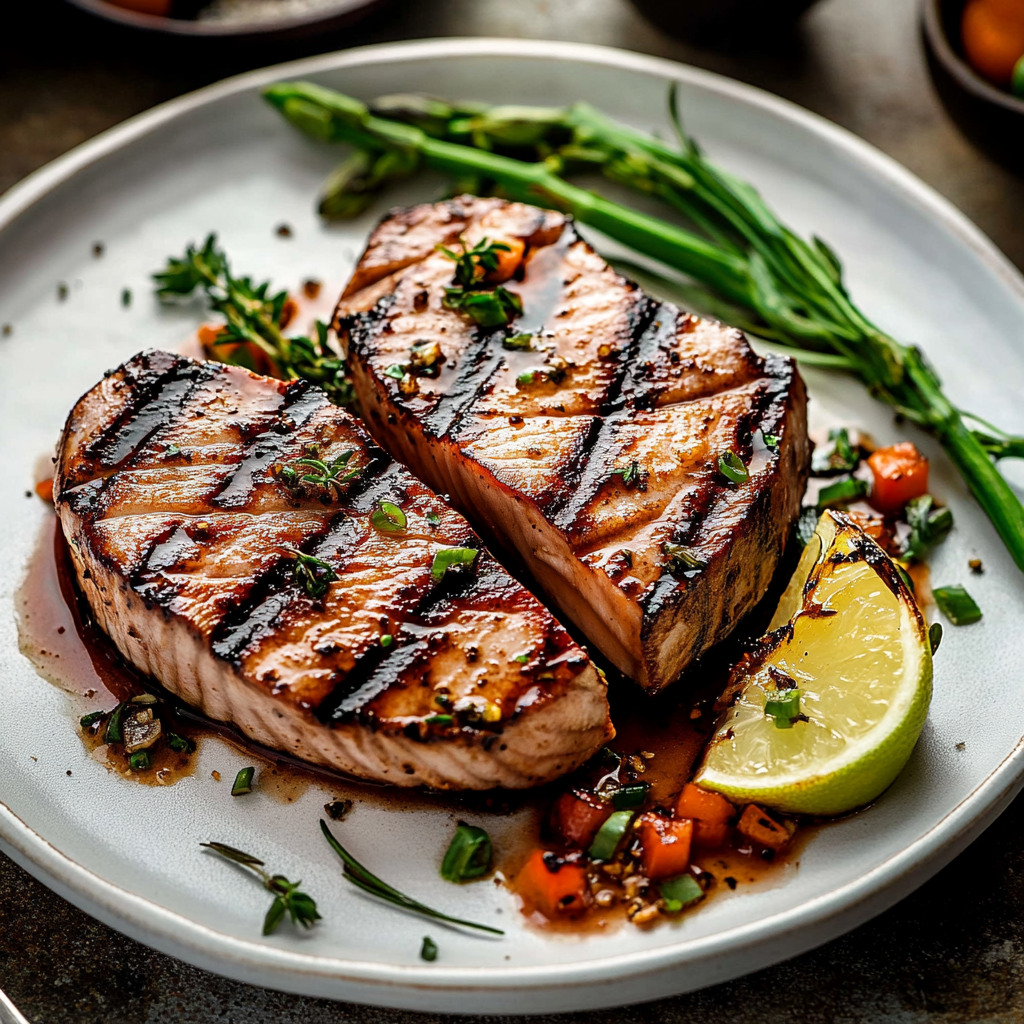
FAQs
What are the best marinades for grilled tuna steaks?
When it comes to marinating grilled tuna steaks, simplicity often reigns supreme. A basic marinade combining olive oil, soy sauce, garlic, ginger, and lime juice works wonders by enhancing flavors without overwhelming them. Allow your tuna to soak in this mixture for at least 30 minutes before grilling—this step ensures maximum taste infusion into every bite!
For those seeking unique twists on traditional marinades: consider experimenting with teriyaki sauce blended with sesame oil or even citrus-based options like orange juice mixed with honey! These variations introduce exciting new dimensions while still respecting tuna’s natural essence—providing an unforgettable dining experience!
How do I know when my grilled tuna steaks are done?
Determining when your grilled tuna steaks are done requires careful observation! The best method involves using an instant-read meat thermometer—the ideal internal temperature for medium-rare is around 125°F (51°C). Insert this tool into the thickest part of each steak; as soon as it reaches desired warmth—remove them from heat immediately!
Another way? Observe color changes: perfectly cooked steak should exhibit bright pink hues at its center alongside firm yet yielding texture upon gentle pressure! Remember: err on caution as residual heat continues cooking after removing from fire—allow them some resting time post-grilling ensures optimal juiciness throughout.
Can I grill frozen tuna steaks?
While it’s technically possible to grill frozen tuna steaks directly without thawing first—a process called “flash cooking”—it’s generally recommended you thaw them beforehand for best results! Cooking frozen fish unevenly leads often results in dry outer layers combined with undercooked centers which detracts from overall quality!
To safely thaw: place sealed packages overnight inside refrigerator prior use—or immerse sealed bags under cold running water until soft enough handle comfortably; afterwards pat dry before seasoning/marinating prior grilling!
What sides pair well with grilled tuna steaks?
Grilled tuna steaks pair excellently well alongside various sides! Opting for light salads featuring crisp greens tossed lightly vinaigrettes complements richness beautifully whilst maintaining balance across all dishes presented at table—think arugula tossed together cherry tomatoes & cucumber slices drizzled citrusy dressing!
Alternatively: roasted vegetables such as bell peppers zucchini asparagus dressed lightly olive oil prove delightful accompaniments too; their earthy notes harmonize flawlessly against savory tones emanating from freshly cooked fish! Don’t forget starchy options like quinoa couscous pilaf seasoned herbs adds satisfying components rounding out entire meal nicely!
Is it safe to eat rare-grilled tuna?
Yes! Eating rare-grilled tuna considered safe given proper sourcing practices followed throughout preparation stages ensuring high quality standards upheld during fishing/handling processes involved beforehand—it’s why sushi-grade classifications exist specifically targeting those who enjoy consuming raw seafood dishes regularly too!
However if concerns arise regarding potential risks associated consuming undercooked proteins always consult local guidelines concerning food safety regulations tailored regionally based upon environmental factors affecting specific areas where caught supplies originate ensuring peace-of-mind whenever indulging!
How should I store leftover grilled tuna steaks?
Storing leftover grilled tuna stakes properly helps maintain flavor integrity & texture longer than usual storage methods might allow otherwise! Allow cooked portions cool completely before wrapping securely in airtight containers refrigerated within two hours post-cooking time—this minimizes potential spoilage risks encountered during prolonged exposure room temperature environments outside refrigiration zones!
For maximum freshness aim consume leftovers within three days following initial preparation time frame; reheat gently just until warmed through avoiding excessive reheating which could lead drying out resultant product ruining overall enjoyment derived from original dish created initially!
Conclusion
In summary, mastering grilled tuna steaks requires attention to detail across multiple aspects—from selecting high-quality ingredients down through proper cooking techniques employed throughout preparation stages right onto presentation methods utilized serving guests delightfully plated creations worth savoring together family friends alike!
Avoiding common mistakes such as overcooking skewed seasonings dirty grills ensures optimal outcomes achieved consistently every single cookout gathered around backyard barbecues homes everywhere hosting special occasions celebrating life’s moments shared lovingly together—the artistry behind crafting unforgettable meals lies within blending simple steps thoughtfully executed harmoniously achieving culinary perfection ultimately leading joyful experiences cherished forevermore!
